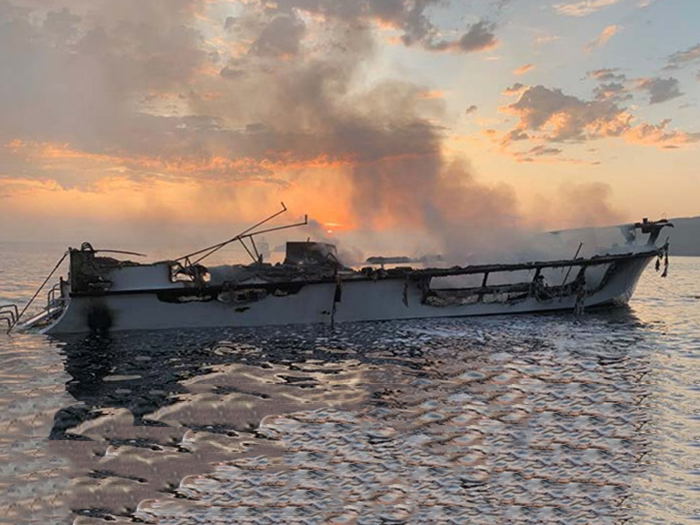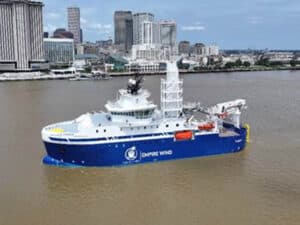
Deadly dive boat fire: NTSB seeks major small passenger boat safety improvements
Written by Nick Blenkey
Conception’s burned hull at dawn on Sept. 2, 2019, prior to sinking. [Image: Ventura County Fire Department]
The National Transportation Safety Board (NTSB) on Tuesday, October 20, called for major safety improvements to small passenger vessels after its investigation of a 2019 California dive boat fire that killed 34 people.
The 75-foot recreational diving vessel, Conception, operated by Truth Aquatics, with 33 passengers and six crew aboard, was anchored in Platts Harbor, off Santa Cruz Island, when it caught fire in the early morning of September 2, 2019. All 33 passengers and one crewmember died of smoke inhalation after they were trapped in the berthing area while a fire raged on the deck above. Both exits from the berthing area led to the fire- and smoke-filled enclosed area above.
The NTSB called for all vessels similar to the Conception with overnight accommodations to be required to have interconnected smoke detectors in all passenger areas.
It also recommended that a secondary means of escape lead into a different space than the primary exit, in case a single fire blocks both escape paths.
The NTSB also called on the U.S. Coast Guard to develop and implement an inspection program to verify that roving patrols are conducted—as required—for the safety of sleeping passengers and crew. NTSB investigators found the absence of a required roving patrol on the Conception likely delayed the initial detection of the fire, allowed for its growth, precluded firefighting and evacuation efforts and directly led to the high number of fatalities in the accident.
“The Conception may have passed all Coast Guard inspections, but that did not make it safe,” said NTSB Chairman Robert Sumwalt. “Our new recommendations will make these vessels safer, but there is no rule change that can replace human vigilance.”
The recommendations to the Coast Guard would apply to vessels, like the Conception, that are under 100 gross tons and have overnight accommodations for 49 or fewer passengers that fall under Subchapter T of federal marine regulations. The NTSB’s recommendation on interconnected smoke detectors, meaning when one smoke detector alarms the remaining detectors also alarm, also would apply to larger Subchapter K vessels.
The NTSB also reiterated its call for small passenger vessels to be required to implement a safety management system to improve the safety culture of vessel owners and operators.
While the Conception had smoke detectors in the below-deck berthing area, they were not connected to each other or the wheelhouse, and there were no smoke detectors in the salon, the common area above the sleeping quarters where investigators believe the fire started. Because of the fire damage to Conception, which burned to the water line and then sank, there was little physical evidence for investigators to establish exactly how, when and where the fire started.
During a virtual board meeting October 20, the NTSB determined the probable cause of the fire and subsequent sinking was the failure of Truth Aquatics Inc., the owner and operator of Conception, to provide effective oversight of its vessel and crewmember operations, including requirements to ensure that a roving patrol was maintained, which allowed a fire of unknown cause to grow, undetected, in the vicinity of the aft salon on the main deck.
Contributing to the undetected growth of the fire was the lack of a Coast Guard regulatory requirement for smoke detection in all accommodation spaces. Contributing to the high loss of life were the inadequate emergency escape arrangements from the vessel’s bunkroom, as both exited into a compartment that was engulfed in fire, thereby preventing escape.
The full, revised investigative report will be issued in the next few weeks, meantime a synopsis of the investigation’s findings and recommendations is available HERE.




